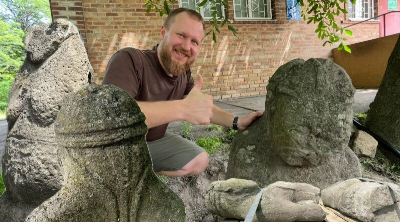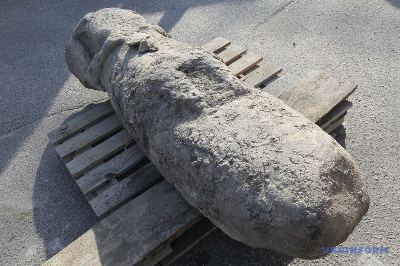
© https://m-merydian.com.ua/
Унікальна культурна операція з порятунку кам’яних скульптур доби середньовіччя — половецьких баб — триває на сході України. Команда українських істориків, волонтерів і військових вже евакуювала 11 статуй з територій, які опинилися в зоні бойових дій. Їх переміщено до Дніпровського національного історичного музею — найбільшої у світі колекції половецької монументальної скульптури. Ці фігури, створені понад 800 років тому кочовими народами степу — половцями (куманами), є безцінною пам’яткою духовної та матеріальної культури. Вони зображують як чоловіків-воїнів, так і жінок — у прикрасах, з ритуальними посудинами, подекуди — вагітних. Встановлені на курганах, ці баби виконували функцію сакральних маркерів території, були пов’язані з культом предків і шаманськими практиками. Операцію координує історик Юрій Фанигін, який разом з військовими проводить евакуацію пам’яток із зон обстрілів. Нещодавно в селі Слов’янка, поблизу адміністративного кордону Дніпропетровської та Донецької областей, команда вилучила статую жінки з посудиною — реліквію, яка, як зазначає Фанигін, «ніколи не мала покидати це місце, але війна змусила». Частину баб було вивезено з Великих Новосілок та Межової — сіл, які зараз перебувають під постійною загрозою обстрілів. Деякі скульптури були вже пошкоджені уламками снарядів. Інші втрачено ще у 2014 році, коли Росія захопила частину Донбасу разом із музеями і їхніми фондами. Директор Дніпровського музею Олександр Старик наголошує, що ці статуї мають не лише історичну, а й ідеологічну вагу: вони спростовують міфи про «виключно слов’янське походження» південного сходу України. «У нашому степу жили скіфи, сармати, кіммерійці, половці. Це складна мозаїка народів. І саме вона — наше справжнє коріння», — говорить він. Колекція музею нараховує понад 100 половецьких баб. Не всі місцеві спільноти схвально сприймають евакуацію. Після вивезення однієї з баб мешканці Слов’янки подали заяву до поліції, вважаючи, що пам’ятку «викрали». Колону зупинили, дорогу заблокували трактором. Після перевірки документів конфлікт владнали. Попри ризики, команда планує нові виїзди. Проте не всюди вдається дістатись: деякі баби лишаються біля міст, повністю охоплених бойовими діями. «Ми рятуємо не лише камінь — ми рятуємо пам’ять», кажуть історики.
Ukraine Doesn’t Forget Its Stone Ancestors: Polovtsian Statues Rescued from the Frontlines in Dnipro
A unique cultural operation to save medieval stone sculptures — the Polovtsian babas — is ongoing in eastern Ukraine. A team of Ukrainian historians, volunteers, and soldiers has already evacuated 11 statues from areas affected by active combat. These valuable artifacts have been relocated to the Dnipro National Historical Museum, which houses the world’s largest collection of Polovtsian monumental sculpture. Created over 800 years ago by nomadic steppe tribes known as the Cumans (or Polovtsians), the statues are a priceless testimony to both the spiritual and material heritage of early medieval peoples. They depict both male warriors and richly adorned women, some holding ritual vessels, others shown pregnant. Typically erected on burial mounds, the statues served as sacred territorial markers, closely tied to ancestor worship and shamanic traditions. The operation is led by historian Yurii Fanyhin, who — together with Ukrainian military personnel — oversees the evacuation of these cultural monuments from shelling zones. In one recent mission in the village of Slovianka, near the administrative border of Dnipropetrovsk and Donetsk regions, the team retrieved a statue of a woman holding a vessel — a relic which, as Fanyhin noted, “was never meant to leave this place, but the war left us no choice.” Several other statues were rescued from the villages of Velyka Novosilka and Mezhova — both of which are currently under constant threat of bombardment. Some of the sculptures had already been damaged by shell fragments. Others were lost as early as 2014, when Russia occupied parts of the Donbas region along with museums and their collections. According to Oleksandr Starik, director of the Dnipro museum, these statues carry not only historical but also ideological significance. They directly challenge the narrative of a “purely Slavic origin” of southeastern Ukraine. “Scythians, Sarmatians, Cimmerians, Polovtsians — our steppe was home to a rich mosaic of peoples. That diversity is our true heritage,” he said. The museum’s collection now includes over 100 babas. However, not all local communities welcome the evacuation efforts. Following the removal of one statue, residents of Slovianka filed a police report, believing it had been stolen. The convoy transporting the sculpture was stopped, and the road was blocked by a tractor. The situation was resolved after officials verified the documents. Despite the risks, the team continues to plan new rescue missions. Still, not all statues can be reached: some remain near cities engulfed in intense fighting. “We’re not just saving stone — we’re preserving memory,” the historians emphasize.

©
1570